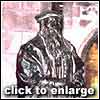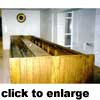
|
Part Two: The Covenanters: The Kirk and its impact on the people By Brian Orr Have a question? Click Here to go to Brian's own Discussion Board!
So far as the general populace was concerned, they do not appear to have been much concerned with the mechanics and management by Presbyteries and whether or not there was a General Assembly until about 1625 when Charles I came to the throne. But from then on resentment of his policies and increased taxation of the burgesses filtered down to all levels who hitherto had been mainly concerned with their day-to-day existence. There were also periods when the Kirk took a firmer hold on society such as with a growth of Puritanism and the Presbyterianism of Andrew Melville.
It was through the "Kirk Session" - the local church court, that the day to day life of the congregation was overseen. Conceptually, the Kirk session was responsible at local level for matters of conscience and religion but in practice ranged across practically everything. Amidst the turmoil the Presbyterian way sought to bring social discipline and extended to drunkenness, excesses of all kinds whether drink or style of dress, fornication, oppression of the poor such as excessive taxation; deception in matters of buying and selling; and lewd behaviour. The Presbyterian way also looked to helping "the deserving poor" - the victims of old age and misfortune; the sick, the elderly the widow and the fatherless but was strongly opposed to helping the idle and beggars . With this social conscience came the ambitious proposal for a national education scheme which would educate the young and provide a teacher in every church. Free education for the poor and the general requirement of education would in time be reflected in the relative literacy of emigrants and the ethos that a good education is important.
The main offence heard by the Kirk session seems to have been adultery and fornication. The penalty for adultery was to stand dressed in sackcloth, bare headed and bare feet at the Kirk door then on the stool of repentance in front of the congregation for perhaps six months or longer. Sometimes the punishment included fines and whipping. Few resisted as under a law of 1581 the adulterer who refused the Kirk's punishment could be put to death.
In the period 1574 to 1612 Puritanism and the zealous Presbyterianism of Andrew Melville gained a foothold that punished a wide range of alleged excesses. This included attacks on Christmas and traditional holidays such as Midsummer Eve. Pilgrimages, dancing, carol singing, merrymaking at weddings, and wakes; and failing to work on Christmas Day were all subject of condemnation. In 1579 a law was passed banning Sunday travel, bodily recreation and drinking. The rules were relaxed for a while, but a second and more intense phase of Puritanism appeared after 1638 with a renewed vigour that was subsequently endorsed by Oliver Cromwell. In 1656 the ultimate law was passed that forbade frequenting taverns, dance, listening to profane music, wash, brew ale or bake bread, to travel or conduct any business on a Sunday. This, for example, led to punishment of children for playing on a Sunday, and a public warning about carrying water, sweeping the house or clearing ashes from the fire place. In Glasgow there were paid spies to report lapses by the congregation.
In the 17th century school started at the age of five and meant to continue for five years before the child might pass to a higher school or university depending on ability. The peasant child though might leave by age eight to help the family by work, particularly during the harvest. The school day often started at 6.00 am in summer and lasted between eight and twelve hours with breaks of an hour for breakfast and lunch.. The teaching varied with the ability of the school master but always focussed on "godliness and good manners". Everyone learned to read and write and many schools taught Latin to the more able student. In the burgh schools they taught arithmetic. Compulsory attendance at church was common and the children would be required to discuss the sermon and its meaning on the Monday. The Restoration of Charles II saw some easing of the rules but this lasted only to about 1690 when the General Assembly made a determined attempt to return to stringent controls. However, over time the repressive rules were adhered to less and less and were only kept by the Seceding churches that had broken away from the Church of Scotland. In the South of Scotland strict observance of the Sabbath continued well into the 18th century but the Highlands remained outside as did the beggars and vagabonds.
Meet the Author, Brian Orr, Researcher with The Guild of One Name Studies
Back to The Covenanters, Main Page
Part One: The Covenanters: Who Were They?
Covenanters Time Line
|
Thursday, December 26th, 2019
Attention visitors: Tartans.com is back. Please note that this is a snapshot of the site as it existed nearly 20 years ago and you may encounter broken links; we are still combing through the site and correcting those as we find them. Please also note that some sections are currently not functional, primarily the discussion forums/clan chat boards.
|
** HOME - First Time Visitors - Glossary - - Contact Us ** Awards | Bibliography | Clan Calendar | Clan Chat | Clan Finder | History | Famous Scots | Genealogy | Great Hall of the Clans | Links | News and Features | Scots on the Net | Search | Site Map The Gathering of the Clans
Copyright 1995- Tartans.com - All Rights Reserved. |





